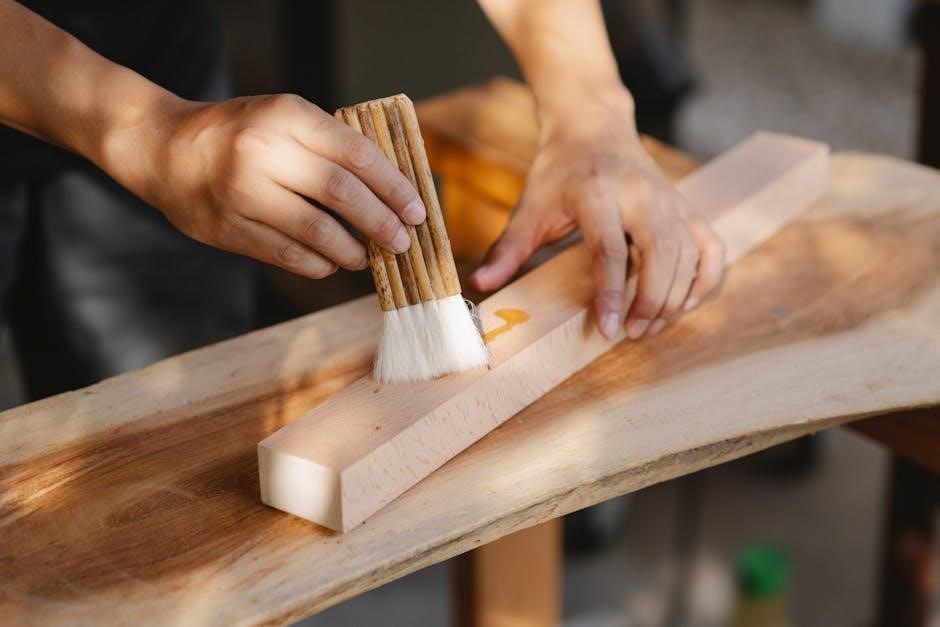Conduit pipe bending is a critical skill in electrical and plumbing systems, requiring precision to ensure safe and efficient installations. This guide focuses on manual measurement techniques.
1.1 Importance of Accurate Measurements in Conduit Bending
Accurate measurements are critical in conduit bending to ensure proper fits, safety, and functionality. Errors can lead to poor connections, safety hazards, and increased material costs. Precise measurements prevent rework, saving time and resources. They also ensure compliance with electrical codes and standards. In manual bending, accurate measurements are the foundation for achieving the desired bend angles and radii. Without them, the integrity of the entire system can be compromised. Thus, mastering measurement techniques is essential for both novice and experienced professionals to deliver reliable and efficient conduit installations.
1.2 Brief History and Evolution of Conduit Bending Techniques
Conduit bending techniques have evolved significantly over the years, transitioning from rudimentary manual methods to advanced mechanical and digital approaches. Early techniques relied on basic tools and manual calculations, often leading to inaccuracies. The mid-20th century saw the introduction of standardized measurement tables, enhancing precision and efficiency. The 1960s and 1970s brought hydraulic bending machines, reducing manual effort and improving consistency. Modern advancements include digital calculators and software for precise measurements, though manual techniques remain essential for field adjustments. Despite these advancements, the fundamental principles of conduit bending, such as accurate measurements and proper tool usage, have remained consistent; This evolution reflects the balance between traditional craftsmanship and technological innovation in the trade.

Materials and Tools Required for Conduit Bending
Conduit bending requires specific materials like PVC, galvanized steel, or aluminum pipes, along with tools such as benders, cutters, and measuring tapes for precise manual operations.
2.1 Types of Conduit Pipes and Their Uses
Understanding the types of conduit pipes is essential for proper bending and installation. Common types include PVC conduit, rigid metal conduit (RMC), and intermediate metal conduit (IMC). Each has specific applications. PVC conduit is lightweight, corrosion-resistant, and ideal for underground or corrosive environments. RMC is durable and used in commercial and industrial settings for high protection. IMC offers a balance between RMC and EMT, providing strength and flexibility. EMT (electrical metal tubing) is lightweight and used for exposed or concealed electrical systems. Flexible conduit is used in tight spaces or for equipment that vibrates. Choosing the right type ensures safety, durability, and compliance with electrical codes. Proper bending techniques vary by material, so knowing the pipe type is crucial for accurate measurements and successful installations.
2.2 Essential Tools for Measuring and Bending Conduit
To accurately measure and bend conduit pipes, specific tools are necessary. A conduit bender, available in manual or hydraulic models, is the primary tool for shaping pipes. A measuring tape or ruler ensures precise length measurements. A radius gauge helps determine the correct bend radius, while marking tools like markers or soapstone mark the bending points. A spirit level guarantees proper alignment, and a protractor measures angles for complex bends. Spring-type tubing cutters are useful for trimming conduit ends, and a workbench provides a stable surface for bending. These tools collectively ensure accuracy and efficiency in conduit bending tasks.

Safety Precautions for Conduit Bending
Always wear PPE, ensure a secure workspace, and use proper tools. Avoid overbending, which can cause damage or accidents, ensuring a safe bending process.
3.1 Safety Tips for Handling Conduit Pipes
Handling conduit pipes requires careful attention to safety to prevent injuries and damage. Always wear gloves to protect your hands from sharp edges and cuts. Use proper lifting techniques to avoid straining your back, ensuring the pipe is securely supported. Keep the workspace clean and clear of debris to minimize tripping hazards. When cutting or bending, secure the pipe firmly to prevent sudden movements. Avoid overreaching or bending in awkward positions. Store conduit pipes upright or on stable racks to prevent them from falling. Use protective eyewear when cutting or grinding pipes to shield against flying particles. Never handle conduit pipes near open flames or sparks if they are coated with flammable materials. Regularly inspect pipes for damage before use to ensure they are safe to handle. Proper safety practices ensure a secure working environment and protect against potential risks.
3.2 Personal Protective Equipment (PPE) Recommendations
When bending conduit pipes, safety is paramount. Always wear safety glasses to protect eyes from debris. Heavy-duty gloves prevent hand injuries and improve grip. Use steel-toe boots to safeguard feet from falling tools or pipes. A dust mask is essential when cutting or grinding conduit to avoid inhaling dust. Ensure loose clothing is tied back, and avoid jewelry that could catch on equipment. Hearing protection, such as earplugs, is recommended when using noisy machinery. Proper PPE ensures a safer and more controlled bending process, reducing the risk of accidents and injuries.

Understanding Conduit Pipe Measurements
Accurate measurements are vital for successful conduit bending. Standard tables provide precise data for various pipe sizes and bends, ensuring consistency and reliability in installations.
4.1 Standard Measurement Tables for Conduit Bending
Standard measurement tables are essential for accurate conduit bending, providing pre-calculated angles, lengths, and radii for various conduit sizes and types. These tables, often found in manuals or online resources, help electricians and technicians ensure precise bends, reducing errors and waste. They typically include data for common conduit materials like EMT, PVC, and rigid steel. By referencing these tables, professionals can determine the exact measurements needed for specific bends, ensuring compliance with industry standards. Understanding how to interpret and apply these tables is crucial for achieving consistent, professional results in conduit installations. Regular updates to these tables reflect advancements in materials and techniques, making them a reliable resource for any conduit bending project.
4.2 How to Read and Interpret Measurement Charts
Reading measurement charts for conduit bending involves identifying conduit size, desired bend angle, and corresponding radius. Match the conduit size to the angle and radius. Ensure units are consistent. Use the chart to set bending tools accurately, marking the conduit as needed. Practice with sample charts to improve understanding and accuracy, ensuring safe and precise bends. Always refer to visual aids or diagrams for clarity. This systematic approach helps in achieving accurate measurements and proper conduit fitting.

Step-by-Step Guide to Measuring Conduit Pipes
Accurate measurements are crucial for conduit bending. Use a measuring tape to determine the pipe’s length, then consult a measurement table to find the correct radius and angle.
5.1 Measuring the Length of Conduit Pipes
Accurately measuring the length of conduit pipes is essential for precise bending. Use a tape measure or ruler to determine the total length required for the installation. Ensure the pipe is straight and free from bends during measurement. Record the measurement carefully, as even small errors can lead to improper fits. For curved sections, measure the length needed for the bend, referring to the manual measurement table for guidance. Always double-check measurements before cutting or bending to avoid waste and ensure compliance with project specifications. Proper measurement is the foundation of successful conduit bending, so take your time to get it right.
5.2 Calculating the Radius and Diameter for Bending
Calculating the radius and diameter is essential for precise conduit bending. The radius is the distance from the bend’s center to its outer edge, while the diameter is twice the radius. For manual calculations, use the formula: diameter = 2 × radius. Measure the conduit’s outer diameter using a caliper or measuring tape. Refer to standard measurement tables to find the recommended radius for your conduit size and type. Ensure the radius aligns with the desired bend angle to avoid kinking or flattening. Double-check calculations to prevent errors, as incorrect measurements can lead to improper fits or weakened conduit integrity. Always follow project specifications for accurate results.

The Bending Process Explained
The bending process involves marking the conduit according to manual measurement tables, applying controlled force to achieve the desired angle, and ensuring accuracy for secure installations.
6.1 Preparing the Conduit Pipe for Bending
Before bending, ensure the conduit pipe is clean and free from debris. Inspect for any damage or imperfections that could affect the bending process. Measure and mark the pipe according to your manual measurement table to determine the exact bending point. Use a bending table or clamp to stabilize the pipe, ensuring it is securely held in place. Apply the correct amount of lubrication to reduce friction during bending. Double-check all measurements and alignments to avoid errors. Proper preparation ensures a smooth and precise bending process, minimizing the risk of damage to the pipe or tools.
6.2 Step-by-Step Bending Technique
Begin by positioning the conduit pipe in the bender, aligning the marked measurement with the bending die. Secure the pipe firmly to prevent movement. Slowly apply pressure to the bending lever, gradually forming the desired angle. Use the measurement table as a reference to achieve precise bends. Once the bend is complete, inspect the conduit for accuracy and smoothness. If adjustments are needed, repeat the process with refined measurements. Ensure the bend radius meets specifications to avoid damage to the conduit. Proper technique ensures reliability and safety in electrical installations. Always follow safety guidelines to prevent accidents during the bending process.

Common Bending Techniques
Manual bending techniques involve precise calculations and tools to shape conduit pipes accurately. These methods are widely used for creating specific angles and curves in electrical installations.
7.1 Manual Bending vs. Hydraulic Bending
Manual bending and hydraulic bending are two distinct methods used in conduit pipe bending, each with unique advantages. Manual bending relies on physical effort and simple tools, making it cost-effective for small-scale projects. Hydraulic bending, on the other hand, uses machines to apply precise force, ensuring consistency and accuracy, especially for complex bends. Manual bending is portable and ideal for on-site adjustments, while hydraulic bending is faster and reduces fatigue in large-scale applications. Choosing between the two depends on the project’s size, budget, and required precision. Both methods require skill, but hydraulic bending offers superior control for intricate shapes and repetitive tasks. Understanding their differences helps in selecting the most suitable technique for specific conduit bending needs;
7.2 Specialized Bending Techniques for Complex Shapes
Specialized bending techniques are essential for creating intricate conduit shapes, such as helical bends or compound curves. These methods often require custom tools or dies to achieve precise angles and radii. For complex shapes, manual measurement tables provide critical data to ensure accuracy. Advanced techniques may involve multi-step bending processes, where the conduit is gradually shaped to fit specific design requirements. In some cases, heat induction or specialized hydraulic systems are used to maintain material integrity. Proper alignment and careful planning are crucial to avoid kinking or deforming the conduit. By combining manual measurements with advanced tools, professionals can achieve highly customized bends for unique applications. Regular practice and adherence to measurement charts are key to mastering these specialized techniques.

Troubleshooting Common Bending Issues
Identifying measurement errors, misalignment, or material defects early prevents costly rework. Adjusting dies, re-measuring, and inspecting conduit for damage ensures accurate and reliable bending results.
8.1 Identifying and Fixing Measurement Errors
Measurement errors in conduit bending can lead to improper fits and safety hazards. Common issues include incorrect radius or angle measurements. To identify errors, compare your measurements with standard tables. Double-check calculations and ensure the conduit aligns with the specified bend degree. If a bend is too tight or loose, adjust the radius or angle accordingly. Use a caliper to verify the pipe’s diameter and ensure it matches the measurement table. For complex bends, refer to pre-calculated charts to avoid mistakes. Always measure twice and bend once to minimize errors. Fixing errors early prevents wasted material and ensures a professional finish.
8.2 Solving Common Problems During the Bending Process
During conduit bending, issues like uneven bends, kinks, or over-bending often arise. To address these, ensure accurate measurements and use the correct die size. If the conduit kinks, carefully heat the affected area and gently reform it. For over-bends, start over with a new conduit piece. Lubricate the conduit and bending die to reduce friction and prevent damage. Regularly inspect tools for wear and tear. Always follow the manufacturer’s guidelines for bending limits and techniques. Proper alignment and gradual bending can minimize errors. Using a manual measurement table helps maintain consistency. Practice and patience are key to mastering the process and avoiding common pitfalls.

Maintenance and Care of Bending Tools
Regularly clean and lubricate bending tools to prevent rust and wear. Store equipment in a dry place and schedule routine inspections to ensure optimal performance and accuracy.
9.1 Cleaning and Storing Bending Equipment
Cleaning and storing bending equipment is essential for maintaining its longevity and performance. After use, remove dirt and grease with a solvent or damp cloth. Inspect for damage or wear. Store tools in a dry, cool place, away from direct sunlight. Avoid stacking heavy objects on bending equipment to prevent deformation. Regularly check for rust and apply a rust-inhibiting coating if necessary. For hydraulic tools, drain fluids and store in an upright position. Proper storage ensures tools remain accurate and ready for future use. Always follow the manufacturer’s guidelines for specific cleaning and storage recommendations.
9.2 Regular Maintenance to Ensure Accuracy
Regular maintenance of bending tools is crucial for maintaining accuracy and extending their lifespan. Start by lubricating all moving parts to prevent friction and wear. Inspect tools for any signs of damage or misalignment and address issues promptly. Calibrate bending equipment according to the manufacturer’s guidelines to ensure precise measurements. Store tools in a dry, clean environment to avoid rust or corrosion. Organize tools properly to prevent accidental damage. Schedule routine checks to identify and replace worn components. By following these steps, you can ensure your bending tools remain reliable and accurate for consistent results in conduit bending projects.

Advanced Tips for Precision Bending
Use laser guides for precise alignment and invest in high-quality dies. Regularly calibrate tools and practice consistent bending techniques to achieve professional-grade results efficiently.
10.1 Using Laser Guides for Accurate Measurements
Laser guides are invaluable for achieving precise measurements in conduit bending, particularly when paired with manual techniques. These tools project a beam of light that helps align and measure conduit pipes accurately, reducing human error significantly. By integrating laser guides into your workflow, you can ensure consistent results, especially in complex or large-scale projects. They enhance efficiency by allowing quick adjustments and provide real-time visual feedback, making it easier to achieve the desired bends. For professionals seeking superior accuracy and reliability, laser guides are an essential addition to traditional manual methods, ensuring that every measurement meets the highest standards.
10.2 Optimizing the Bending Process for Efficiency
To enhance efficiency in conduit bending, plan your workflow meticulously. Use pre-measured templates and organize tools to minimize setup time. Incorporate advanced tools like laser guides for precise alignment, reducing errors and rework. Streamline the process by batching similar bends together, maintaining consistent angles, and ensuring proper pipe support. Regularly inspect and maintain equipment to avoid mid-process disruptions. Utilize manual measurement tables to quickly reference standard bends, saving time during calculations. Train staff to follow standardized techniques, improving consistency and speed. Finally, implement quality control checks to identify inefficiencies and continuously refine workflows for optimal productivity.
Mastery of manual measurement techniques is essential for precise conduit bending, ensuring reliability and safety in electrical installations. Continuous practice enhances efficiency and accuracy.
11.1 Key Takeaways from the Guide
Mastering conduit pipe bending requires precision, patience, and adherence to proven techniques. Accurate measurements are crucial for achieving professional results. Always use reliable tools and follow safety protocols to avoid injuries and damage. Understanding standard measurement tables and interpreting them correctly ensures proper bending angles and radii. Regular tool maintenance and proper storage extend equipment lifespan and maintain accuracy. Practice manual bending techniques to develop muscle memory and consistency. For complex shapes, consider advanced methods but start with foundational skills. Troubleshooting common issues early prevents costly rework. Finally, continuous learning and adaptation to new tools and techniques will elevate your expertise in conduit bending.
11.2 Final Thoughts on Mastering Conduit Bending
Mastering conduit bending requires patience, practice, and a deep understanding of manual measurement techniques. By following the guidelines and tips outlined in this guide, you can achieve precise bends consistently. Always prioritize safety and accuracy, as these are the cornerstones of successful conduit installations. With time and experience, you’ll develop the skills to tackle even the most complex bending tasks with confidence. Remember, precision bending is not just about completing a task—it’s about ensuring reliability and durability in electrical and plumbing systems. Keep refining your techniques, and you’ll become a proficient conduit bender, capable of delivering professional-grade results every time.

